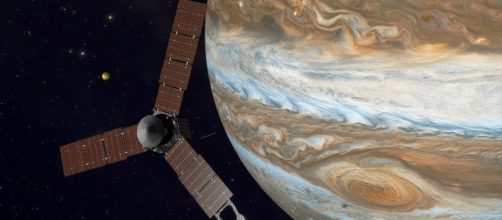As of today, Juno is at approximately 12, 2 million km (7.6 million miles) from reaching Jupiter. Upon arriving to the planned distance from Jupiter, the main engine will ignite for 35 minutes, locking it at a polar orbit around the giant planet, at about 4,600 km (2858 miles). For over a year, Juno will examine the radiation belts, auroras, and below the dark clouds of gas into the interior of Jupiter.
Threats of hydrogen under strong pressure
This will be the closest distance that any spacecraft is from Jupiter. In 1974 NASA´s pioneer 11's closest approach to Jupiter only reached 43,000 km (27,000 miles).
Scientists think that Juno approaching Jupiter presents serious risks to the spacecraft, as below the cloud tops where Juno will fly, there is a layer of highly pressurized hydrogen that functions as an electrical conductor.
Polar orbit around Jupiter
It´s believed that the combination of hydrogen along with the planets rotation produces a strong magnetic field where electron, protons and ions move at the speed of light. Juno might be exposed to strong radiation equivalent to one hundred million times the X-rays used in hospitals; however the polar orbit that Juno is intended to take places it under the belt that radiates highly energetic particles, allowing the spacecraft to have a longer useful life.Juno´s orbit is like a squashed oval that approaches Jupiter at the North Pole and then descends below the radiation belts, as Juno flies toward Jupiter´s South Pole.
Juno´s orbit was designed to maneuver the spacecraft away from the nearing the harmful radiation.
Titanium vault to protect against radiation
Juno is equipped with special shielding that protects its electrical wiring and sensors from the harmful radiation. The highest protective piece of equipment which Juno carries is a titanium vault, which encloses Juno´s flight computer and the main electronic science components of the mission. This titanium vault is intended to reduce the radiation exposure by about 600 times from the one affecting the exterior; resulting in Spacecraft Juno´s long lasting performance in that orbit.
Without the protective vault of titanium, it´s thought that Juno would not be able to perform a single flyby around Jupiter.
While the extreme radiation found in Jupiter, over time might be able to cause damage to the overall spacecraft, the polar orbit will allow Juno to perform science studies for approximately 20 months, a sufficient amount of time to gather useful information from the gas giant, including important data about the origins of life.

